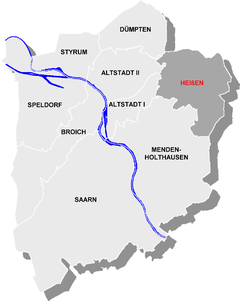Be called
|
Hot district 5 of Mülheim an der Ruhr |
|
|---|---|
| location | |
| Basic data | |
| Area : | 8.88 km² |
| Residents : | 21,117 (December 31, 2014) |
| Population density : | 2,378 inhabitants per km² |
| Incorporated on: | January 1, 1910 |
|
District before incorporation: |
District of Mülheim an der Ruhr |
| Average Altitude : | 108 m above sea level NHN |
| Postal code : | 45472 |
| Area code : | 0208 |
| structure | |
| District : | Rechtsruhr-Süd Rechtsruhr-Nord |
| District number: | 5 |
| image | |
|
Market square with Mercy Church and old mayor's office |
|
Heißen is a district of the independent city of Mülheim an der Ruhr in North Rhine-Westphalia . In addition to the formerly independent community of Heißen, the districts of Winkhausen, Fulerum and Heimaterde are also part of the district.
location
Heißen is the easternmost district of Mülheim and is located in the Rechtsruhr-Süd district, with the exception of the statistical district of Winkhausen (Heißen-Nord), which belongs to Rechtsruhr-Nord. It is located on the historic Hellweg and borders on Menden-Holthausen , Old Town I , Old Town II , Dümpten and the Essen districts of Frohnhausen , Fulerum and Haarzopf . The district center is located on one of the westernmost foothills of the Westenhellweg , which at this point rises almost 100 m above the Mülheim city center.
history
Heißen is documented as the first district within the later Mülheim urban area: With a document dated February 24, 796, the landowner Hemric (also Hemricus ) transferred a clearing ( Bifang ) in "Silva Heissi" to the hands of Liudger . The forest area mentioned extended north of the Ruhr between today's districts of Heißen and Heisingen . Combined with the entitlement to forest and fishing, this donation formed the basis for the foundation of the Werden monastery a few years later.
In the 11th century, the Fulerum district was first mentioned in a document as a gift from the Count von Berg to the Werden monastery . In the 15th century 13 fireplaces were registered here.
Heißen was an early center of coal mining in the Ruhr area . By 1830 there were a number of small coal - mines , from which later operated holdings, the mines Humboldt who rose flowers Delle and Wiesche emerged.
In 1866 the "Heißen station" was opened on the Osterath – Dortmund Süd railway line. The stopping station was built exclusively for handling coal. Here the Mülheim-Heißen-Altendorf (Ruhr) railway branched off to Dahlhausen via Steele-Süd . The route between Mülheim Hbf and Heißen is known as the "Heißener Berg" .
In the course of the administrative reform in 1878, the previous mayor's office of Mülheim was divided into the mayor offices of Broich, Styrum and Heißen. On August 30, 1879, the newly built mayor's office was occupied.
In 1899 the foundation stone for the " Colonie Wiesche " was laid by the Mülheim Mining Association . In 1914 the two streets "Mausegatt" and "Kreftenscheer" were given their names, derived from old seam names.
In 1910 the district of Mülheim an der Ruhr was dissolved. Most of the community of Heißen with Winkhausen was incorporated into Mülheim. The eastern part of the municipality with most of the village of Fulerum was incorporated into Essen . In the same year, the tram line from Mülheim city center via Heißen to Essen was inaugurated.
In 1918, construction began on the Heimaterde settlement , which was initiated by Krupp authorized representative Max Halbach.
In 1952, mining at the Wiesche colliery was stopped and in 1966, the Rosenblumendelle colliery, the last active colliery in the Mülheim city area, was closed. This made Mülheim the first major city in the Ruhr area to be free of mining.
In 1973, the RheinRuhrZentrum, the largest covered shopping center in Germany at the time , was built on the former site of the Humboldt colliery on the city limits of Essen .
Web links
Individual evidence
- ^ Edeltraud Balzer: Early mission, noble donors and the beginnings of the bishopric in Münster (Part II). (PDF; 42.7 MB) Westphalia-Lippe Regional Association, August 11, 2016, accessed on February 17, 2019 .
- ↑ Heißener Berg at Eisenbahnfreunde Mülheim an der Ruhr eV ( Memento from September 28, 2007 in the Internet Archive )
Coordinates: 51 ° 26 ' N , 6 ° 56' E

